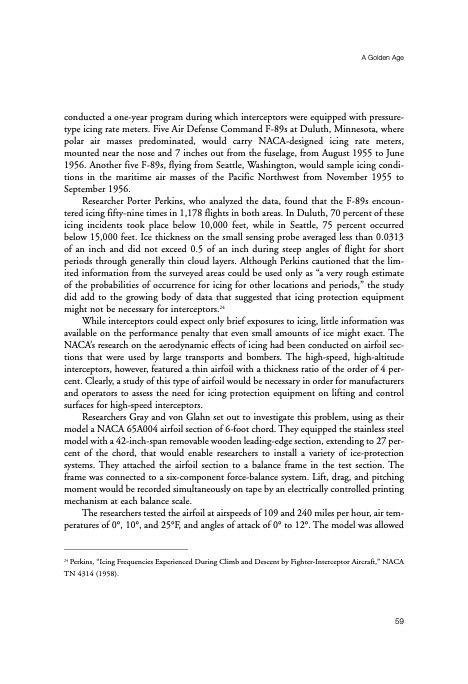
PDF Publication Title:
Text from PDF Page: 072
conducted a one-year program during which interceptors were equipped with pressure- type icing rate meters. Five Air Defense Command F-89s at Duluth, Minnesota, where polar air masses predominated, would carry NACA-designed icing rate meters, mounted near the nose and 7 inches out from the fuselage, from August 1955 to June 1956. Another five F-89s, flying from Seattle, Washington, would sample icing condi- tions in the maritime air masses of the Pacific Northwest from November 1955 to September 1956. Researcher Porter Perkins, who analyzed the data, found that the F-89s encoun- tered icing fifty-nine times in 1,178 flights in both areas. In Duluth, 70 percent of these icing incidents took place below 10,000 feet, while in Seattle, 75 percent occurred below 15,000 feet. Ice thickness on the small sensing probe averaged less than 0.0313 of an inch and did not exceed 0.5 of an inch during steep angles of flight for short periods through generally thin cloud layers. Although Perkins cautioned that the lim- ited information from the surveyed areas could be used only as “a very rough estimate of the probabilities of occurrence for icing for other locations and periods,” the study did add to the growing body of data that suggested that icing protection equipment might not be necessary for interceptors.24 While interceptors could expect only brief exposures to icing, little information was available on the performance penalty that even small amounts of ice might exact. The NACA’s research on the aerodynamic effects of icing had been conducted on airfoil sec- tions that were used by large transports and bombers. The high-speed, high-altitude interceptors, however, featured a thin airfoil with a thickness ratio of the order of 4 per- cent. Clearly, a study of this type of airfoil would be necessary in order for manufacturers and operators to assess the need for icing protection equipment on lifting and control surfaces for high-speed interceptors. Researchers Gray and von Glahn set out to investigate this problem, using as their model a NACA 65A004 airfoil section of 6-foot chord. They equipped the stainless steel model with a 42-inch-span removable wooden leading-edge section, extending to 27 per- cent of the chord, that would enable researchers to install a variety of ice-protection systems. They attached the airfoil section to a balance frame in the test section. The frame was connected to a six-component force-balance system. Lift, drag, and pitching moment would be recorded simultaneously on tape by an electrically controlled printing mechanism at each balance scale. The researchers tested the airfoil at airspeeds of 109 and 240 miles per hour, air tem- peratures of 0°, 10°, and 25°F, and angles of attack of 0° to 12°. The model was allowed A Golden Age 24 Perkins, “Icing Frequencies Experienced During Climb and Descent by Fighter-Interceptor Aircraft,” NACA TN 4314 (1958). 59PDF Image | History of NASA Icing Research Tunnel

PDF Search Title:
History of NASA Icing Research TunnelOriginal File Name Searched:
sp4226.pdfDIY PDF Search: Google It | Yahoo | Bing
NFT (Non Fungible Token): Buy our tech, design, development or system NFT and become part of our tech NFT network... More Info
IT XR Project Redstone NFT Available for Sale: NFT for high tech turbine design with one part 3D printed counter-rotating energy turbine. Be part of the future with this NFT. Can be bought and sold but only one design NFT exists. Royalties go to the developer (Infinity) to keep enhancing design and applications... More Info
Infinity Turbine IT XR Project Redstone Design: NFT for sale... NFT for high tech turbine design with one part 3D printed counter-rotating energy turbine. Includes all rights to this turbine design, including license for Fluid Handling Block I and II for the turbine assembly and housing. The NFT includes the blueprints (cad/cam), revenue streams, and all future development of the IT XR Project Redstone... More Info
Infinity Turbine ROT Radial Outflow Turbine 24 Design and Worldwide Rights: NFT for sale... NFT for the ROT 24 energy turbine. Be part of the future with this NFT. This design can be bought and sold but only one design NFT exists. You may manufacture the unit, or get the revenues from its sale from Infinity Turbine. Royalties go to the developer (Infinity) to keep enhancing design and applications... More Info
Infinity Supercritical CO2 10 Liter Extractor Design and Worldwide Rights: The Infinity Supercritical 10L CO2 extractor is for botanical oil extraction, which is rich in terpenes and can produce shelf ready full spectrum oil. With over 5 years of development, this industry leader mature extractor machine has been sold since 2015 and is part of many profitable businesses. The process can also be used for electrowinning, e-waste recycling, and lithium battery recycling, gold mining electronic wastes, precious metals. CO2 can also be used in a reverse fuel cell with nafion to make a gas-to-liquids fuel, such as methanol, ethanol and butanol or ethylene. Supercritical CO2 has also been used for treating nafion to make it more effective catalyst. This NFT is for the purchase of worldwide rights which includes the design. More Info
NFT (Non Fungible Token): Buy our tech, design, development or system NFT and become part of our tech NFT network... More Info
Infinity Turbine Products: Special for this month, any plans are $10,000 for complete Cad/Cam blueprints. License is for one build. Try before you buy a production license. May pay by Bitcoin or other Crypto. Products Page... More Info
| CONTACT TEL: 608-238-6001 Email: greg@infinityturbine.com | RSS | AMP |